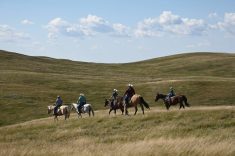Corral gates, or any long, heavy gates that need to be securely stable and never sag, require a deep and sturdy post that won’t lean, shift or work up out of the ground with frost heaves. A post not set deep enough, or in unstable ground, will eventually shift with the weight of the gate, and it will sag and drag.
Some soils are challenging for holding posts. Wet areas usually need some rock fill before you can set a secure gate post. Subsurface water (even if the top of the ground is never wet) may make it difficult to hold a post in place. Some people put concrete around a post, which works well in some situations, but isn’t always a perfect solution.
To make sure a gate post never rots, it’s wise to use full-treated pressure-treated posts, and this is why some folks like to use railroad ties. They are sturdier than most round posts and last a long time, being fully pressure-treated from top to bottom.
Read Also

Harvest wraps up and fall work begins
At the Eppich famly ranch in western Saskatchewan, the fall harvest was successful with few breakdowns, cows and calves have been sorted and a new tractor has arrived
In our corrals, we’ve used a lot of railroad ties as gate posts since they are sturdy enough to hold a long, heavy gate. In one area however, we still had trouble keeping the posts from shifting. The gates either started sagging or rising too high (enabling calves to shimmy underneath) because of frost heaves. Even though we hauled in many loads of rocks before we built the corral in that area since it was the best location for corrals, there is still a problem with underground water channels that carry subsurfacewater through the area.
Freezing and thawing in winter often results in frost heaves, and the gates in our main corral kept shifting, with the railroad ties being shoved upward. When we rebuilt the old corrals this past winter, we realized we needed to set the posts deeper, below that watercourse.
We wanted to use railroad ties again, but they were not tall enough to be set that deeply, and still have enough above-ground height to hang a big gate.
Our son, who now has a custom-fencing business, had faced this challenge on several other jobs, and he had to be innovative to make things work. He helped us rebuild our old corrals and create some taller posts.
Using two railroad ties, he offset and bolted them together to make the final post taller above ground and much deeper below ground. He used a mini excavator to dig the deep holes for these posts, and filled in with rock when he placed the posts so they can never shift. These posts go a lot deeper than the subsurface water, so there is a good chance they will not be affected by changes in moisture or by frost heaves. This will make it much easier to keep using our corrals working cattle, sorting, etc., without having sagging gates that don’t swing easily. In our old age, perfectly swinging gates will be a blessing!















